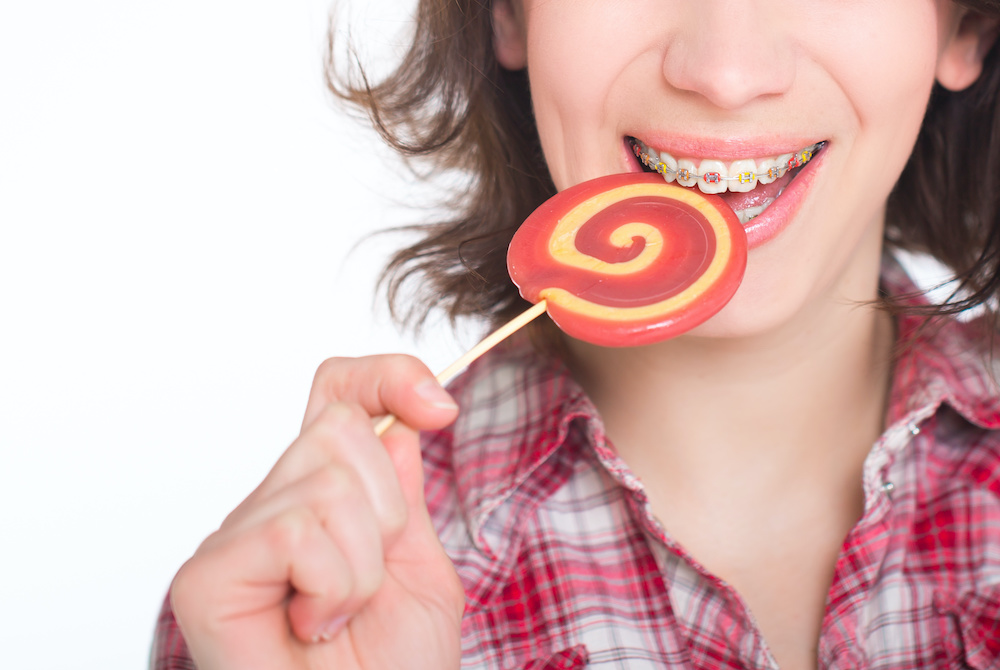Braces, for many, symbolize a transformative journey toward a perfect smile. Yet, alongside the excitement of this new path, it is normal to wonder how they will affect your ability to eat the foods you like. “Will I have to bid farewell to my favorite candy bar? Will popcorn at the movies now be a distant memory?
Embracing orthodontic treatment, including braces, involves temporary adherence to specific dietary guidelines to protect your evolving smile. Consider it a time to discover new foods and perhaps even healthier eating habits.
Ask anyone who’s been through the braces journey, and they’ll likely tell you that every bite adjusted, every treat postponed, is all worth it for that final reveal.
Understanding Your Food Choices with Braces
Braces consist of delicate components. While designed to withstand typical wear, some foods can compromise or damage them. Certain foods increase the risk of oral health issues when particles become trapped.
Your First Few Days with Braces: Embracing Soft Foods
New braces often equate to a sensitive mouth. If you can eat normally, that’s great, it can help your sore teeth feel better faster. If not, you may want to try eating soft, gentle foods that help minimize discomfort as your teeth adjust:
- Oatmeal: This comforting choice isn’t just soothing; it’s a nutritional powerhouse.
- Scrambled Eggs: Easy to chew, they offer the protein your body craves.
- Soups: Warm, comforting, and varied—watch the temperature.
- Pasta: Opt for softer-cooked shapes to ensure ease.
- Seafood: Particularly fish varieties that flake easily.
- Soft Vegetables: Steamed or boiled, they’re packed with vital nutrients.
- Mashed Potatoes: Creamy, filling, and utterly comforting.
- Soft Cheeses: Delicious, calcium-rich, and perfect for those with braces.
- Bananas: Nature’s soft and sweet offering.
- Yogurt: Creamy and versatile, perfect for any time of the day.
- Ice Cream: Cold treats are not only comforting but the cold also helps relieve some of the pressure caused by the wires.
Foods to Approach with Caution Initially
Certain foods can intensify sensitivity or pose challenges immediately after getting braces:
- Chewy Breads or Rolls: Might require more force than what’s comfortable. Plus, you can accidentally pop brackets off!
- Chewy Cuts of Meat: Could pose difficulty in the initial days.
Foods to Avoid with Braces
While embracing your journey to a healthier smile, there are certain foods you’ll want to steer clear of completely. Anything hard, sticky, or difficult to bite into can pose a risk of broken appliances and prolonged treatment. These foods can damage brackets, dislodge wires, or lead to other complications. Here’s a list to keep in mind:
- Hard Candy: A risk to both braces and teeth.
- Corn On the Cob and Whole Apples Biting directly can dislodge brackets or bend wires.
- Sticky Candy: Taffy, caramel, and the like can adhere stubbornly to braces.
- Popcorn: Those kernels are braces’ worst enemy.
- Nuts: Their hard nature poses a direct risk.
- Crunchy Veggies/Fruits: When uncooked, they can apply undue pressure.
- Pizza Crust: Especially when it’s crispy and hard.
- Bagels or Hard Rolls: Their density can be a challenge.
- Ice: Crunching is a definite no-go with braces.
- Snack Chips & Pretzels: Any kind of hard or crunchy food may cause your bracket to break or cause damage to your wires.
10 Essential Tips for Eating with Braces
Embarking on your orthodontic journey can be exciting. Yet, it brings along a set of nuances, especially regarding your diet. Adjusting to eating with braces doesn’t have to be daunting. Here are some expert-approved tips to make the process smoother and more comfortable:
- Start Small: Initially, cut your food into small pieces. This minimizes the need to bite directly with your front teeth, which can be sensitive or risky with new braces.
- Go Soft: Opt for softer foods right after tightening your braces. Think mashed potatoes, yogurts, and smoothies. These foods require less chewing and put minimal pressure on your braces.
- Avoid Extreme Temperatures: Be wary of foods or drinks that are too hot or cold. Extreme temperatures can heighten tooth sensitivity, especially during the early days of braces.
- Sidestep Stickiness: Sticky foods can adhere to your braces, making cleaning challenging. If you have to chew gum, we recommend sugar-free gum, which can sometimes help with soreness.
- Chew with Care: Slow down and chew your food gently. Braces can be delicate, and aggressive chewing might dislodge a bracket or distort a wire.
- Beware of Crunch and Crisp: Hard foods such as raw carrots, apples, or crusty bread might damage the brackets or wires. It’s best to cook, steam, or bake these to a softer consistency or cut them into manageable slices.
- Swish and Rinse: After eating, swishing water around your mouth is beneficial to dislodge any food particles stuck in or around your braces. This prevents plaque build-up and staining.
- Invest in the Right Tools: Carry a travel toothbrush or invest in a water flosser. Brushing and flossing can be a lifesaver, ensuring your braces remain clean, especially after meals.
- Stay Hydrated: Drinking water throughout the day keeps you hydrated and helps keep your mouth clean. It assists in rinsing away food debris and acidic residues.
- Listen to Your Orthodontist: Your orthodontist will provide specific guidelines about avoiding foods and ways to take care of your braces. Their advice stems from years of experience and knowledge, so it’s essential to follow their recommendations.
Take the Next Step
Ready to achieve and maintain that perfect smile? Find a dedicated AAO orthodontist near you and get the expert care you deserve. Visit our orthodontist locator today.



